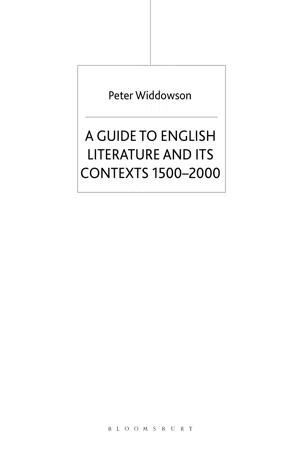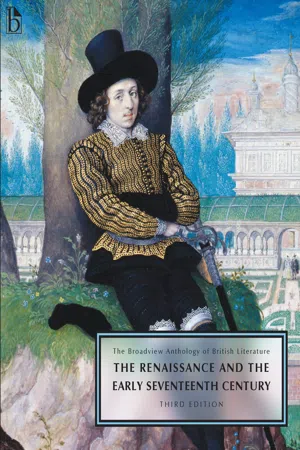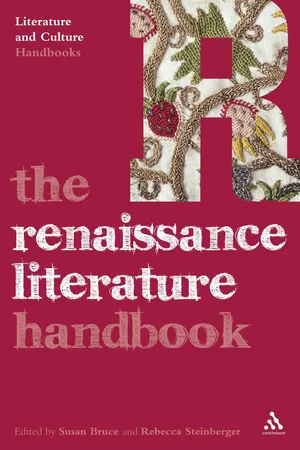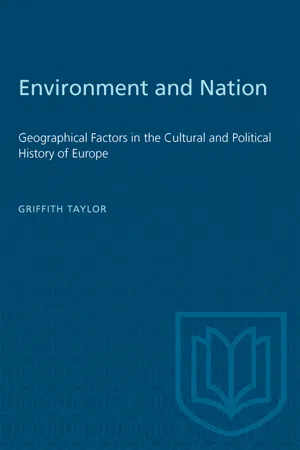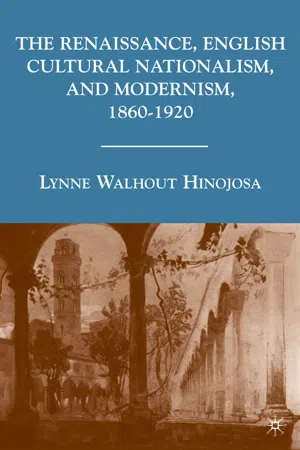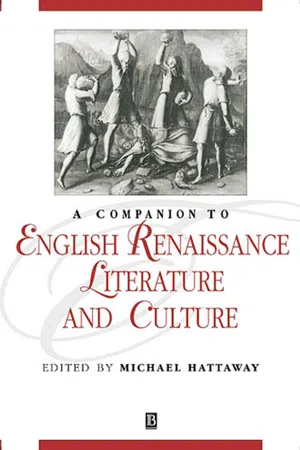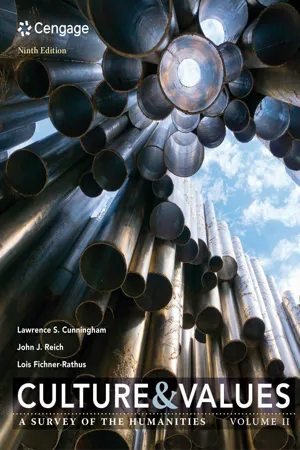History
The English Renaissance
The English Renaissance, spanning from the late 15th to the early 17th century, was a cultural and artistic movement characterized by a revival of interest in classical learning, literature, and the arts. It marked a period of significant advancements in literature, including the works of William Shakespeare and Christopher Marlowe, as well as developments in music, architecture, and science.
Written by Perlego with AI-assistance
Related key terms
1 of 5
10 Key excerpts on "The English Renaissance"
- eBook - PDF
- Peter Widdowson(Author)
- 2017(Publication Date)
- Red Globe Press(Publisher)
But cultural historians believe that the effects of the Reformation slowed the Renaissance process down in England, and there is certainly no achievement in the visual arts to match that of 15th-and 16th-century Italy. The height of The English Renaissance, then, and especially so in literature (although also in music, architecture and art), belongs to the later Elizabethan period, indicative events in the late 1570s and early 1580s being the building and opening of the first public theatres in London and the composition by Sir Philip Sidney, a quintessential type of the Renaissance ‘gentleman’, of his Arcadia (the ‘Old’ version) and Defence of Poetry . However, general characteristics of cultural developments throughout the period would include: as a reflex of the Reformation, a great increase in printed works in the English language, resulting in a rapid rise in literacy; the enforced spread of English in Wales and Ireland, and then its exportation to the New World; a new sense of 1500–1649: T H E E N G L I S H R E F O R M A T I O N A N D R E N A I S S A N C E 5 national identity and pride which fostered confidence in using English for serious writing (rather than Latin) and for the creation of a national literature which would compete with those in classical and other European languages; a huge expansion in vocabulary (it is estimated that during the century and a half from c .1500, exploration, trade, translation and scholarship caused well over 10,000 new words to enter English from Latin, Greek, European and other languages, as well as neologisms created by native authors); a consequent linguistic exuberance and innovativeness in literary style, form and genre; and the development of a literature which enthusiastically explored the social, political, religious, cultural and emotional implications of newly liberated, human-centred experience. - No longer available |Learn more
The Broadview Anthology of British Literature: Concise Volume A - Third Edition
The Medieval Period - The Renaissance and the Early Seventeenth Century - The Restoration and the Eighteenth Century
- Joseph Black, Leonard Conolly, Kate Flint, Isobel Grundy, Wendy Lee, Don LePan, Roy Liuzza, Jerome J. McGann, Anne Lake Prescott, Barry V. Qualls, Jason Rudy, Claire Waters(Authors)
- 2016(Publication Date)
- Broadview Press(Publisher)
Recent generations of scholarship have done much to destabilize this conceptual framework. Medievalists have located a variety of “renaissances” in, for example, the ninth and the twelfth centuries, and have thor- oughly debunked the idea that the supposed “dark ages” were lacking intellectual or cultural life. Scholars have also distinguished among the later renaissances of the fourteenth through sixteenth centuries: a renaissance in Italy that began in the early fourteenth century (with the writings of Dante and Petrarch and the paintings of Giotto) and reached its full flowering in the late fif- teenth and early sixteenth centuries (the age of Machia- velli, of Leonardo da Vinci, and of Michelangelo); a renaissance that occurred in northern Europe in the late fifteenth and early sixteenth centuries, especially in the Low Countries but also manifesting itself in France and in England (among the leading figures of this renaissance were the great Humanist thinkers Desiderius Erasmus and Sir Thomas More, and the painters Jan van Eyck and Hans Holbein); and a renaissance that occurred in England toward the end of the sixteenth century in the latter part of the reign of Elizabeth I (the age of Edmund Spenser, Sir Philip Sidney, and Christopher Marlowe as well as Shakespeare). Other scholars, though, have questioned whether or not England ever experienced anything that can properly be termed a “Renaissance.” At a minimum, then, the phenomena associated with “the Renaissance” extended over a considerable stretch of time and across much of Europe. But they were not isolated from one another, sharing a tendency to focus on human concerns in new ways (and, in the visual arts, to depict the human form in persuasively realistic if often idealized representations). Historically too, the various renaissances were connected by a variety of direct links, many of them stemming from royal initiatives. - Joseph Black, Leonard Conolly, Kate Flint, Isobel Grundy, Wendy Lee, Don LePan, Roy Liuzza, Jerome J. McGann, Anne Lake Prescott, Barry V. Qualls, Jason Rudy, Claire Waters(Authors)
- 2016(Publication Date)
- Broadview Press(Publisher)
Recent generations of scholarship have done much to destabilize this conceptual framework. Medievalists have located a variety of “renaissances” in, for example, the ninth and the twelfth centuries, and have thor-oughly debunked the idea that the supposed “dark ages” were lacking intellectual or cultural life. Scholars have also distinguished among the later renaissances of the fourteenth through sixteenth centuries: a renaissance in Italy that began in the early fourteenth century (with the writings of Dante and Petrarch and the paintings of Giotto) and reached its full flowering in the late fif-teenth and early sixteenth centuries (the age of Machia-velli, of Leonardo da Vinci, and of Michelangelo); a renaissance that occurred in northern Europe in the late fifteenth and early sixteenth centuries, especially in the Low Countries but also manifesting itself in France and in England (among the leading figures of this renaissance were the great Humanist thinkers Desiderius Erasmus and Sir Thomas More, and the painters Jan van Eyck and Hans Holbein); and a renaissance that occurred in England toward the end of the sixteenth century in the latter part of the reign of Elizabeth I (the age of Edmund Spenser, Sir Philip Sidney, and Christopher Marlowe as well as Shakespeare). Other scholars, though, have questioned whether or not England ever experienced anything that can properly be termed a “Renaissance.” At a minimum, then, the phenomena associated with “the Renaissance” extended over a considerable stretch of time and across much of Europe. But they were not isolated from one another, sharing a tendency to focus on human concerns in new ways (and, in the visual arts, to depict the human form in persuasively realistic if often idealized representations). Historically too, the various renaissances were connected by a variety of direct links, many of them stemming from royal initiatives.- eBook - PDF
- Susan Bruce, Rebecca Steinberger, Susan Bruce, Rebecca Steinberger(Authors)
- 2009(Publication Date)
- Continuum(Publisher)
Part I The Renaissance Period This page intentionally left blank The Historical Context of 1 English Renaissance Literature: From Conflict to Creativity William J. Kerwin Chapter Overview Health Crises and Body Conflicts: Plague and Pox 24 Intellectual Conflicts: Humanism and Modern Media 27 Religion and Conflict: The Reformation 29 Gender Conflict: Women in Their Places 31 Economic Conflict: Building a New Market World 33 Outward Conflict: Looking Outside England 35 Political Conflict: From Feudal Kingdom to Modern State 37 The English Renaissance produced what is perhaps the greatest literature in English history: the range and quality of its poetry, and most especially of its drama, surpass that produced in any other period. The extraordinary richness of the literature produced in the Renaissance might lead one to ask why some epochs nurture artistic creation so much more powerfully than others. What aspect or aspects of an historical moment enable the production of great writing? What is the relation between ideas and the history which surrounds them? There have been a number of different answers to these questions. Some have denied that history plays any significant part at all, insisting that great minds alone suffice to produce great literature. Others have claimed that art needs peace, and that the stability afforded by the end of the Wars of the Roses (which begins our period, with the accession of Henry VII) afforded the authors the time and space to write their plays and their poetry (and in some cases, even, their prose). Both of these views privilege the author (and the text) 23 over ‘history’ (or context), but the mid- twentieth century saw a challenge to that view of the relation between text, author and context. - eBook - PDF
- W.H. Vogel, A. Berke(Authors)
- 2009(Publication Date)
- SPB Academic Publishing(Publisher)
The Renaissance 158 The Renaissance Introduction Historical The period after the early Middle Ages has no defined beginning. Since the 19th century, it has been called the ‘Renaissance’, which means rebirth (rinascere ital.). It is reckoned to have started in late 13th century Florence. The writings of Dante Alighieri (1265– 1321) and Francesco Petrarch (1304–1374) and the paintings of Giotto di Bondone (1267–1337) are considered the germs of this new cultural movement, which extended from the beginning of the 14th century to the middle of the 17th century. For the first two centuries, the Renaissance was an Italian phenomenon, with Italian views dominating the rest of Europe. Later the Renais-sance spread throughout most of Europe. During that time, Italy and most of the European countries were engaged in internal power struggles as well as wars amongst each other. City states in Italy, such as Milan, Venice, Florence, Rome and Naples, and small dukedoms and kingdoms in other countries fought bitterly and bloodily with each other, as indi-vidual rulers and nobles strove for territory and power. At one time The Holy Roman Empire included Italy, Germany and Aus-tria, but its emperors soon lost power, since the individual nobles, dukes and kings became more powerful. In France, the French found themselves engaged in the ‘hundred year’ war with Eng-land (which actually lasted from 1337–1453) and the dukes of Burgundy and later the house of Bourbon rose to power. In Eng-land, the different lineages of the royal family fought each other, leading eventually to the War of the Roses (1455–1485). In addi-tion, England was in constant conflict with Scotland and Ireland. On the Iberian Peninsula, the power of the Muslim regime was finally broken in the 15th century and Spain and Portugal became the dominant powers. - eBook - PDF
Environment and Nation
Geographical Factors in the Cultural and Political History of Europe
- Griffith Taylor(Author)
- 2019(Publication Date)
- University of Toronto Press(Publisher)
CHAPTER XI THE RENAISSANCE IN TIME AND SPACE A. The Development and Spread of the Universities It is hardly possible to define in a few words what is meant by the Renaissance. It involved a period of time marked by a rapid evolu-tion of culture-but the time and the character of the culture differed considerably from place to place. It is this latter aspect of the prob-lem-the migration and modification of the Renaissance as it pro-gressed-which makes the geographical treatment of considerable interest. Throughout much of its development it is closely linked with Humanism and with the Reformation. It would be foolish, however, to look upon it as a factor in national differentiation of the same importance as language or religion . It was rather a phase in human progress which was largely-though not wholly-confined to the Western half of Europe; at any rate in the earlier, more significant stages of the Renaissance. Yet its roots are to be found in the South-east-and a later phase of its flowering is to be perceived in the North-east. In the present brief survey of the Renaissance, our attention will be confined mainly to two phases, first, the growth of a more liberal and modern frame of mind, which is labelled Humanism, and, secondly, the progress in the Arts will be illustrated by the develop-ment of architecture. Both subjects illustrate very clearly that shift of the area of notable social evolution from the Southeast to the West which marked the close of Medieval Times. It has already been stated that it is difficult to date the beginning or end of the Renaissance. Still there are considerable differences in its stages of development and it will be found helpful to consider these for a moment before discussing them separately. The following four periods seem to be fairly well-defined, at any rate in the areas including Italy, France, England and Germany. They are illustrated in the four maps (Figs. 48 to 51). - L. Hinojosa(Author)
- 2009(Publication Date)
- Palgrave Macmillan(Publisher)
The tension between high and low culture was also a dominant concern in late nineteenth- and early twentieth-century England. When Symonds wrote his volumes on the Renaissance in the 1870s and 1880s, English scholars debated whether to replace classical studies in the universities and public schools with a national study of literature in the vernacular and other “modern” subjects. Symonds believed that “the higher culture of the race” would still be grounded in humanism, but that “average stu- dents [would] probably require new methods of teaching the classics” because they had no “special vocation for literature and no aesthetic tastes” ( Renaissance 580). Embedded in interpretations of the histor- ical Renaissance is a dilemma of the late nineteenth century: the rela- tion of classicism to national culture, elitism to popularism. Despite the impossibility of escaping hermeneutic circles, it is instructive to trace through time the development of the Renaissance as a period concept, for one can see how various ideas and questions about nation, modernity, and culture become attached to it. The fol- lowing genealogy draws from, among other studies, three major works that trace the history of the Renaissance concept: Wallace Ferguson’s The Renaissance in Five Centuries of Historical Thought (1948), John Hale’s England and the Italian Renaissance (1954), and J. B. Bullen’s The Myth of the Renaissance in Nineteenth-Century Writing (1994). All three of these scholars agree that by the late nine- teenth century the Renaissance referred to a periodized segment of history, and that by the time of Symonds’s texts the concept of the Renaissance was naturalized in the English language. Because these and others have provided detailed accounts of the concept in England through the late nineteenth century, I outline only briefly the early trajectory here. Throughout its development the concept of the- Michael Hattaway(Author)
- 2008(Publication Date)
- Wiley-Blackwell(Publisher)
The English Icon: Elizabethan and Jacobean Portraiture. London: Routledge and Kegan Paul. —— (1979). The Renaissance Garden in England . London: Thames and Hudson. Thomas, Keith (1978 edn). Religion and the Decline of Magic. Harmondsworth: Penguin. R eferences and F urther R eading Trill, Suzanne (1996). ‘Religion and the Con-struction of Femininity’. In H. Wilcox (ed), Women and Literature in Britain 1500–1700 . Cambridge: Cambridge University Press. Underdown, David (1985). Revel, Riot, and Rebel-lion: Popular Politics and Culture in England 1603–1660. Oxford: Clarendon Press. Woodbridge, Linda (1984). Women and The English Renaissance: Literature and the Nature of Womankind, 1540–1620. Brighton: Harvester. Introduction 9 PART TWO Contexts and Perspectives, c .1500–1650 2 Early Tudor Humanism Mary Thomas Crane There are so many problems with ‘humanism’ both as a term and a concept that one hesitates to use it. For one thing, the noun ‘humanism’ actually dates from the nineteenth century (although ‘humanist’ – umanista in Latin – occurs in the fif-teenth century). In the Renaissance various Latin phrases – bonae litterae , litterae human-iores , etc. were used to describe the scholarly and educational field that we now call humanism. There has been much scholarly debate over many years about how ‘human-ism’ in general is to be defined, and about its nature and scope in Tudor England and elsewhere.- eBook - ePub
Frame, Glass, Verse
The Technology of Poetic Invention in the English Renaissance
- Rayna Kalas(Author)
- 2018(Publication Date)
- Cornell University Press(Publisher)
Before the emergence of the alienable frame, when most frames were continuous with the surface of the painting, there was a material continuity between the frame and the painted image. The fabrication of the picture frame would have revealed that the painted panel with its engaged frame was a “tempered” image, in that it mingled ground pigment with egg, gilt with wood. In its mixture of “simples,” it seemed to recall, if not to embody, the divine tempering of spirit with matter, essence with substance. In iconic devotional images, once the wood had been tempered with gilt, the image ceased to be material and was instead recognized as an incarnation of divinity—its particular mingling of substances recalling the human frame itself as a mingling of bone with flesh and blood, and a mingling of spirit with substance. With linear perspective, painting on canvas, and the trade in art, however, the function of the frame shifted: instead of merging with the design, the frame now contained and ornamented it. Frames became alienable, interchangeable, and more uniform in shape; the frame became a principle of design for the work of art. Over the centuries this modern quadrilateral frame would come to structure ideas of art (picture frame), history (world picture), and even the very idea of context and contingency (frame of reference).Rather than squaring off a view of the Renaissance—as one might a world picture or an object of study—I propose to “frame” The English Renaissance according to an older sense of the word frame . Remembering that the word frame was first used in the context of language and only later in reference to images, I take my cues principally from poetic language, the medium that has most clearly defined the Renaissance in England. Though my claims are geared mostly to The English Renaissance, it is not my intention to isolate those claims from broader claims about the continental Renaissance. On the contrary, my hope is that the particular example of the Renaissance in England will modify perceptions of the Renaissance that derive largely from the example of the visual arts in Italy, not by supplanting those perceptions but by adjusting them. My aim is to reinvigorate a sense that the temporality of the Renaissance accommodated the poetic sensibility that certain universals or general principles abide in particularities, and thus that the particularities of English poetry can and should inform our overall sense of the Renaissance.I continue to use the period designation Renaissance, albeit not exclusively, in this book. I do so not to conserve an aesthetic view of the period, but to sustain nonetheless an emphasis on imaginative practice, and to bring technology under the rubric of imaginative practice. I use Renaissance also to avoid the teleological implications of early modern, for one of my underlying claims is that the work of the imagination is historically material, but not necessarily as an instrument of progress. The term Renaissance connotes novelty, but only as the rebirth of what is old: English Renaissance writers spoke of the present in relation to the past as much as the future. They spoke of temporal change as both recurrence and novelty. And the capacity to apprehend time by turning forward to the future while also turning backward to the past is one of the distinctive techniques of poetic conceits and tropes. That temporal imagination is codified in older meanings of frame just as it is writ large in a notion of the Renaissance as both backward-looking and forward-facing. Though it was specifically an English phenomenon to name the poetic conceit “a frame of words,” I would argue that the Renaissance frame, even as a material apparatus, was inflected with this poietic sensibility, just as the modern frame would later come to be inflected by a visual concept. As the following pages will show, this modern aesthetically oriented mode of “picturing” has eclipsed the role of the poetic—and the poietic - eBook - PDF
Culture and Values
A Survey of the Humanities, Volume II
- Lawrence Cunningham, John Reich, Lois Fichner-Rathus, , Lawrence Cunningham, John Reich, Lois Fichner-Rathus(Authors)
- 2017(Publication Date)
- Cengage Learning EMEA(Publisher)
Copyright 2018 Cengage Learning. All Rights Reserved. May not be copied, scanned, or duplicated, in whole or in part. Due to electronic rights, some third party content may be suppressed from the eBook and/or eChapter(s). Editorial review has deemed that any suppressed content does not materially affect the overall learning experience. Cengage Learning reserves the right to remove additional content at any time if subsequent rights restrictions require it. 478 | CHAPTER 14 The High Renaissance in Northern Europe and Spain otherworldly nature of the upper canvas. The emotion is high pitched and exaggerated by the tumultuous atmosphere. This emphasis on emotionalism links El Greco to the onset of the Baroque era. His work contains a dramatic, the- atrical flair, one of the hallmarks of the 17th century. musIc As in the visual arts, the Renaissance produced major stylistic changes in the development of music, but in general, musical development in the Renaissance was marked by a less severe break with medieval custom than was the case with the visual arts. Although 16th-century European composers began to increase the complexity of their style, frequently using polyph- ony, they continued to use forms developed in the High Middle Ages and the Early Renaissance. In religious music, the motet remained popular, set to a religious text. Com- posers also continued to write madrigals (songs for three or more solo voices based generally on secu- lar poems). For the most part, these were intended for performance at home, and elaborate, interweav- ing polyphonic lines often tested the skill of the singers. The difficulty of the parts often made it necessary for the singers to be accompanied instrumentally. This increasing complex- ity produced a significant change in the character of madrigals, which were especially popular in Elizabethan England. None- theless, 16th-century musicians were recognizably the heirs of their 13th- and 14th-century predecessors.
Index pages curate the most relevant extracts from our library of academic textbooks. They’ve been created using an in-house natural language model (NLM), each adding context and meaning to key research topics.
